One of the brightest and happiest flowers you can add to your garden is the Rudbeckia Indian Summer plant. It has big golden-yellow blooms that do well in the summer heat. This plant is great for farmers of all skill levels because it doesn’t need much care and is good for pollinators. The Rudbeckia Indian Summer is a great choice whether you’re a new gardener looking for an easy-to-grow perennial or an experienced gardener wanting to add bright color to your summer garden.
This complete guide will teach you everything you need to know about the Rudbeckia Indian Summer plants, including what makes it special, how to grow and take care of it, and fun ways to use it in your garden design.
1. Introduction to Rudbeckia Indian Summer Plant
Rudbeckia Indian Summer, also called Indian Summer Black-eyed Susan, is a unique type of the Rudbeckia hirta species. This flower is often found in summer areas because it blooms for a long time and has bright yellow petals with dark brown centers. Many home gardeners and landscape planners choose it because it can grow in a variety of conditions and attracts pollinators.
- Bright, Long-Lasting Blooms: They bloom from summer to early fall and are a bright yellow color.
- Easy to Care For: Hardy plants like this one don’t need much care.
- Attracts Pollinators: Bugs, birds, and even bees love this plant.
- Versatile in Garden Design: It looks good in borders, pollinator gardens, and other types of gardening.
1.1 Overview of Rudbeckia Indian Summer Plant
To better understand the plant’s characteristics and potential in your garden, here’s a quick overview of the Rudbeckia Indian Summer plant:
- Botanical Name: Rudbeckia hirta ‘Indian Summer’
- Common Name: Indian Summer Black-eyed Susan
- Plant Type: Plants that only live for a short time, often grown as annuals
- Bloom Time: Summer through early fall (June to September)
- Flower Characteristics: The petals are big, golden yellow, and have a dark brown core. They can get up to 6 to 9 inches across.
- Height and Spread: Reaches 3 to 4 feet tall with a spread of about 2 feet
- Hardiness Zones: USDA zones 3-9, making it suitable for a wide range of climates
- Sun Requirements: Thrives in full sun (6-8 hours of direct sunlight per day)
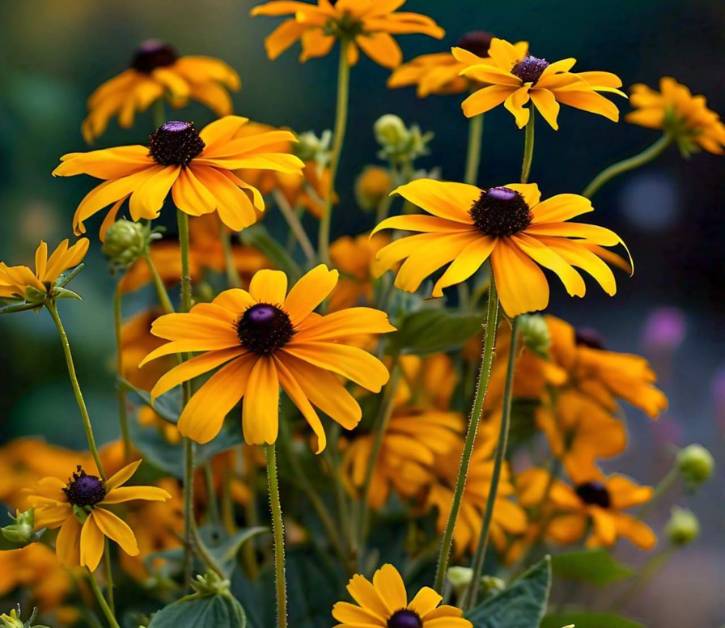
When it comes to flower size, the Rudbeckia Indian Summer plants stands out because its petals can be up to 9 inches across. The bright, showy flowers of this type are what draw pollinators like bees and butterflies to it. It’s a must-have for summer gardening because it blooms for a long time and can handle a range of conditions.
2. Benefits of Planting Rudbeckia Indian Summer
The Rudbeckia Indian Summer plant is a great plant for any garden because it has many benefits. You might want to add it to your landscape for the following reasons:
2.1 Vibrant Summer Blooms
The big, bright blooms of Rudbeckia Indian Summer plant make any garden look brighter. The bright yellow petals and dark brown centers make a beautiful contrast that lasts all summer, so your garden stays colorful even when it’s really hot outside.
2.2 Pollinator-Friendly
Pollinators are drawn to Rudbeckia Indian Summer. The nectar-rich flowers of this plant attract a variety of insects, including bees and butterflies, while the seed heads, which are produced in late summer and fall, attract birds. Planting Rudbeckia Indian Summer plants in your garden will help the local ecosystem and increase the variety of plants that grow there.
2.3 Drought Tolerance
Rudbeckia Indian Summer can handle some drought once it’s established, which makes it a great choice for low-maintenance or water-conscious gardening. It can grow well in hot, dry places because its deep roots help it get water from lower areas of the soil.
2.4 Low-Maintenance Care
This plant doesn’t need much care, which makes it great for people who are new to gardening or want an easy-care annual. Rudbeckia Indian Summer plants will grow well with little work as long as it gets enough sunlight and is watered every once in a while.
2.5 Versatile Garden Use
Rudbeckia Indian Summer plant looks great in a lot of different garden styles, from formal flower beds to cottage-style gardens and pollinator-friendly landscapes. Its tall growth and beautiful flowers make it a great choice for garden borders, mass planting, or gardening in pots.
3. Growing Conditions and Requirements
Giving your Rudbeckia Indian Summer plants the right growing conditions is very important if you want them to do well.
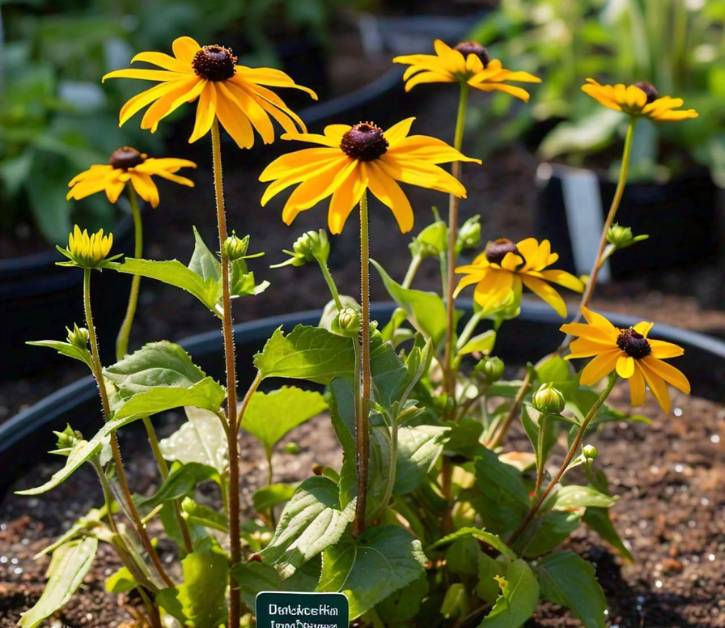
Here are the things this plant needs to grow well:
3.1 Sunlight
Rudbeckia Indian Summer does best in full sun, which means it needs at least 6–8 hours of direct sunlight per day. It can handle some shade, but planting it in full sun will give it the healthiest flowers and general look. As the plant grows in shade, it may get taller and blooms less often.
3.2 Soil
Rudbeckia Indian Summer plant prefers well-draining soil, but it can grow in a lot of different types of soil, such as sandy, loamy, and clay soils. Before planting, you might want to add organic matter like compost to the soil to make it better. This will help the plant keep its water and give it the nutrients it needs.
3.3 Watering
To build a strong root system, it’s important to water often during the first growth season. As the plant grows, it becomes more resistant to dryness and needs less watering to do well. But for the best blooms, make sure the soil stays consistently moist. Root rot can happen if you water your plants too much.
3.4 Temperature and Hardiness Zones
Rudbeckia Indian Summer plants is hardy in USDA zones 3–9, which means it can live through cold winters and hot summers. But severe drought or cold can hurt the plant’s health, so it’s important to give it enough water when it’s dry and protection from frost when it’s cooler.
3.5 Spacing
For air flow and to avoid fungal diseases, the right space is very important. Space plants 18 to 24 inches apart to give them room to grow and keep them from getting too crowded, which can cause problems like powdery mildew.
4. How to Plant Rudbeckia Indian Summer
There is an easy way to plant Rudbeckia Indian Summer, whether you start with seeds or move seedlings. To make sure the planting goes well, do these things:
4.1 Planting from Seeds
- Timing: Plant seeds in the garden after the last frost in early spring, or start them indoors 6 to 8 weeks before the last frost.
- Seed Placement: Cover the seeds only slightly with soil; they need sunshine to grow. Make sure the soil stays wet until the seeds sprout.
- Germination: In most cases, seeds will germinate between 7 to 21 days, depending on the conditions.
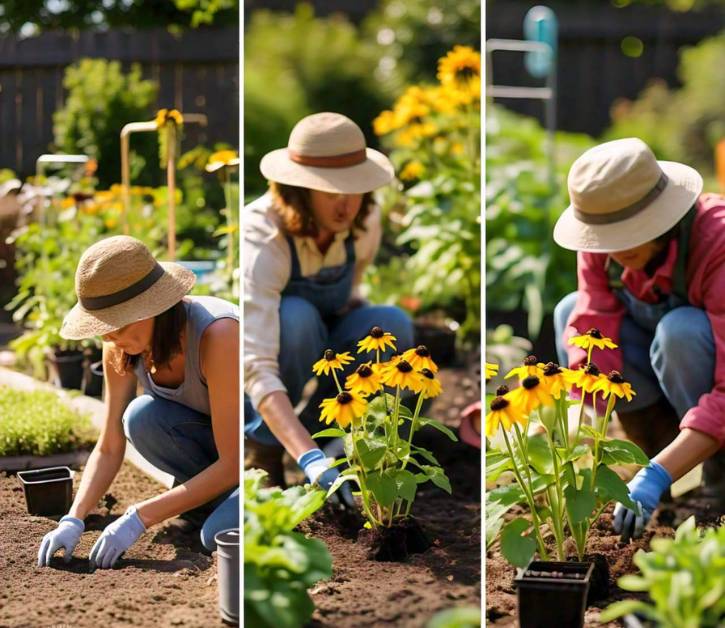
4.2 Planting from Seedlings
- Digging the Hole: It is necessary to dig a hole that is twice as wide and the same depth as the root ball when transplanting seedlings.
- Planting: After placing the plant in the hole, backfill it with soil and apply light pressure to remove any air pockets that may have formed. After planting, make sure to water thoroughly.
- Spacing: In order to prevent overcrowding and to allow for growth, it is important to ensure that plants are spaced 18-24 inches apart.
4.3 Best Time to Plant
Early spring or late summer is the best time to plant Rudbeckia Indian Summer. Early spring is also a good season. The plant is able to establish itself before the hot summer months if it is planted in the early spring, while planting it in the late summer can result in floral production in the fall.
5. Care and Maintenance Tips
It’s easy to take care of Rudbeckia Indian Summer plants, but here are some basic tips that will help your plants stay healthy and grow all season:
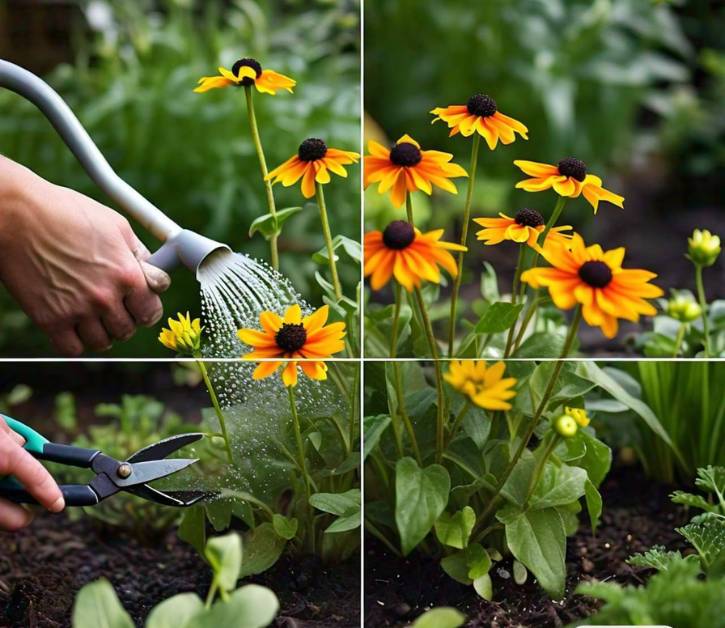
5.1 Watering
If you put Rudbeckia Indian Summer plants, make sure the soil stays moist until the plant gets established. Once the plant is established, water it less often because it will be able to handle less water. But when it’s hot and dry, give them extra water to keep them from getting stressed and to keep them growing.
5.2 Fertilization
Rudbeckia Indian Summer plant doesn’t need a lot of fertilizer. Most of the time, a balanced, slow-release fertilizer sprayed in early spring or compost mixed into the soil before planting is enough. It’s better to be safe than sorry when it comes to feeding plants. Too much fertilizer can make the leaves lush while killing the flowers.
5.3 Deadheading and Pruning
To keep the plant growing, regularly remove spent flowers, also known as deadheading. Not only does this keep the plant neat, but it also helps the plant focus on making new flowers. You can cut the plant all the way back to the ground in late fall to get it ready for the next season.
5.4 Pests and Diseases
Rudbeckia Indian Summer plant doesn’t usually get pests, but it can get fungal diseases like powdery mildew or leaf spots from time to time. Reduce the chance of getting disease by:
- Plants should be put in the right places to help air flow.
- To keep the leaves dry, water the plant from the bottom up.
- Neem oil or organic fungicides can be used to stop breakouts if needed.
6. Landscaping and Design Ideas
Rudbeckia Indian Summer plant is very flexible in the garden and can be used in many different landscaping ideas. Take Rudbeckia Indian Summer into the design of your garden are as follows:
6.1 Cottage Gardens
The happy flowers of Rudbeckia Indian Summer make it a perfect choice for country gardens, where casual and romantic plants create a fun, carefree atmosphere. It looks great with Echinacea (coneflower), Phlox, and Shasta daisies, which are all classic country garden plants. The colors and textures will go well together. Rudbeckia Indian Summer’s bright yellow flowers look beautiful next to the soft pinks, purples, and whites that are popular in cottage gardens.
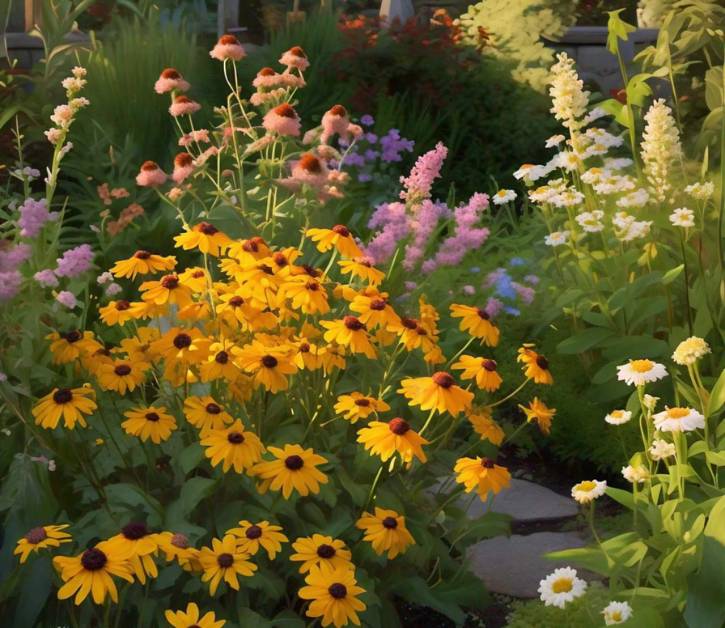
6.2 Pollinator Gardens
It is great for pollinator gardening because Rudbeckia Indian Summer plant is liked by bees, butterflies, and birds. You can make a haven for bees by planting it with lavender, butterfly bush (Buddleia), milkweed, and Joe-Pye weed, all of which have lots of nectar. This not only makes your yard look better, but it also helps biodiversity by giving food to important pollinating species.
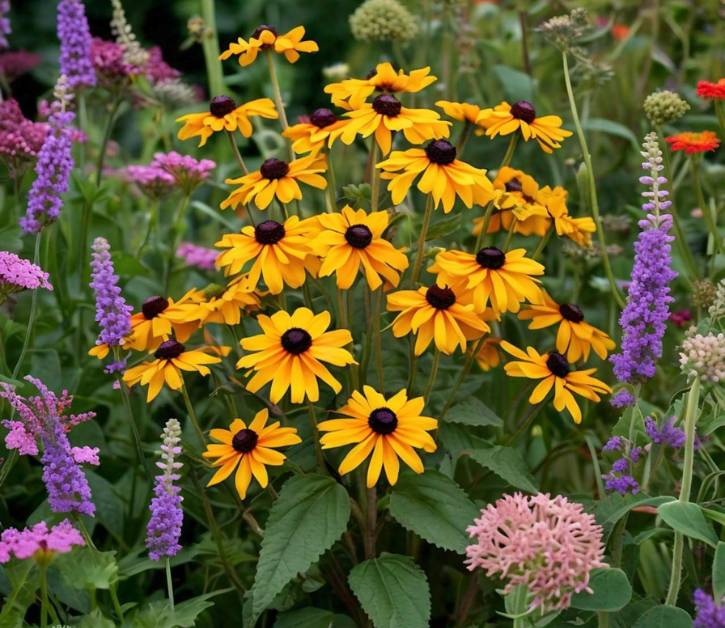
6.3 Garden Borders and Pathways
Because it grows tall and straight, Rudbeckia Indian Summer plants is great for planting along paths or in yard borders. It can be used as a background for shorter plants or mixed with Russian sage, sedum, or decorative grasses to give the garden more texture and movement. Its bright flowers will make a beautiful border that will frame your yard and give it more depth and dimension.
6.4 Containers
Rudbeckia Indian Summer plants does well in big pots as well, which makes it a great choice for patios, balconies, or small gardens. Using potting mix that drains well and making sure the pot is big enough for the plant’s roots are the keys to good container gardening. It looks great in containers with trailing plants like calibrachoa or sweet potato vine, which give the show a full, lush look that is full of color all summer long.
6.5 Mass Planting
Planting a lot of Rudbeckia Indian Summer can make a dramatic and eye-catching show. Putting together several Rudbeckia Indian Summer plants makes a beautiful effect, whether you need to add color to a big garden bed or a part of your garden. This works especially well along fences, property lines, or in meadow-style gardens, where big blocks of yellow flowers can really stand out.
7. Rudbeckia Indian Summer vs. Other Rudbeckia Varieties
Even though Rudbeckia Indian Summer plant is a great plant in its own right, it’s good to know how it stacks up against other well-known Rudbeckia types.
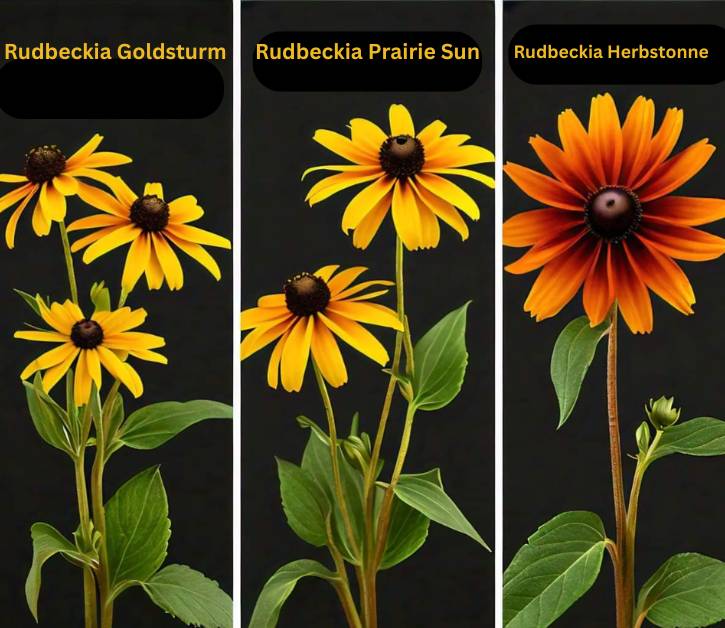
Here are some things that make this type unique:
7.1 Rudbeckia Goldsturm
- Bloom Size: The flowers on Rudbeckia Goldsturm are only 3 to 4 inches across, while the flowers on Rudbeckia Indian Summer are 6 to 9 inches across.
- Color: The petals of both types are bright yellow with dark centers, but Rudbeckia Indian Summer flowers tend to be more vivid and striking.
- Growth Habit: The Rudbeckia Goldsturm has a growth habit that is more compact and bushy, making it an excellent choice for gardens that are smaller or have restricted space. There is a greater height of Rudbeckia Indian Summer, which can grow up to 4 feet in height.
7.2 Rudbeckia Prairie Sun
- Center Color: One big difference is that the center of Rudbeckia Prairie Sun is greenish-yellow, while the center of Rudbeckia Indian Summer plant is dark brown.
- Bloom Time: Both types bloom in the summer and continue to do so until early fall. In some areas, Rudbeckia Prairie Sun may bloom a little longer.
- Height: Rudbeckia Prairie Sun grows 2 to 3 feet shorter than Rudbeckia Indian Summer (up to 4 feet), which makes Prairie Sun a better choice for mid-height borders.
7.3 Rudbeckia Herbstonne
- Size: This Rudbeckia plant grows up to 6-7 feet tall, which makes it much taller than Rudbeckia Indian Summer. This makes it perfect for the back of borders or large fields.
- Bloom Shape: Although both types of Rudbeckia have yellow petals, Rudbeckia Herbstonne has petals that hang down more, making it look more laid-back and casual than Rudbeckia Indian Summer plant, whose petals stand upright.
- Landscape Use: Herbstonne grows best in larger landscapes where its towering presence can be fully enjoyed. Rudbeckia Indian Summer, on the other hand, is more adaptable and can grow in smaller spaces.
Conclusion and Final Tips
Finally, Rudbeckia Indian Summer is a great plant for any garden because it has bright, long-lasting flowers, doesn’t need much care, and can be used in many ways. It’s a favorite among both new and experienced gardeners because it can grow in a wide range of conditions and draw pollinators. This plant is both beautiful and useful all summer long, whether you want to make a bold focal point in your garden or make a place that pollinators will love.
Here are a few last things you can do to make sure Rudbeckia Indian Summer does well in your garden:
- Choose the right location: For the best blooming, make sure your plant gets 6 to 8 hours of sunshine every day.
- Water consistently: Keep the soil moist, especially during the first growing season, to help plants grow strong roots.
- Deadhead regularly: By picking off the old flowers, you can encourage the plant to keep blooming all season.
- Provide good air circulation: Leaving enough space between plants will help keep your garden looking neat and stop fungal diseases.
If you follow these easy steps and add Rudbeckia Indian Summer to your garden, you’ll enjoy its bright flowers and ability to bring pollinators for many years to come.
FAQs
-
What is Rudbeckia Indian Summer plant?
Indian Summer is a type of Black-eyed Susan that has big, bright yellow flowers with dark brown cores. You can grow it as an annual or a short-lived perennial. It grows from summer to early fall.
-
How tall does Rudbeckia Indian Summer grow?
It grows to about 3 to 4 feet tall, which makes it a great plant for adding height and bright color to garden borders or pots.
-
Can Rudbeckia Indian Summer grow in shade?
But it can handle light shade. It does best in full sun (6–8 hours a day). But in shady places, it will bloom less often.
-
Is Rudbeckia Indian Summer drought-tolerant?
Rudbeckia Indian Summer plant can handle some drought once it is established. But giving it regular water during the first growing season helps the roots grow strong.
-
How do I plant Rudbeckia Indian Summer?
Plant seeds early in the spring or plants after the risk of frost has passed. For the best results, make sure the soil drains well and the spot gets full sun.
-
How do I care for Rudbeckia Indian Summer?
During the first growth season, water often, remove spent flowers to make more flowers grow, and don’t fertilize too much. Once it’s established, Rudbeckia Indian Summer doesn’t need much care.
-
Is Rudbeckia Indian Summer good for pollinators?
Yes, it does. It’s a great choice for pollinator-friendly gardening because it brings in bees, butterflies, and birds.
-
Can Rudbeckia Indian Summer be grown in containers?
Yes, if the soil is well-drained and the Rudbeckia Indian Summer plant gets enough sun, it will do very well in big pots.
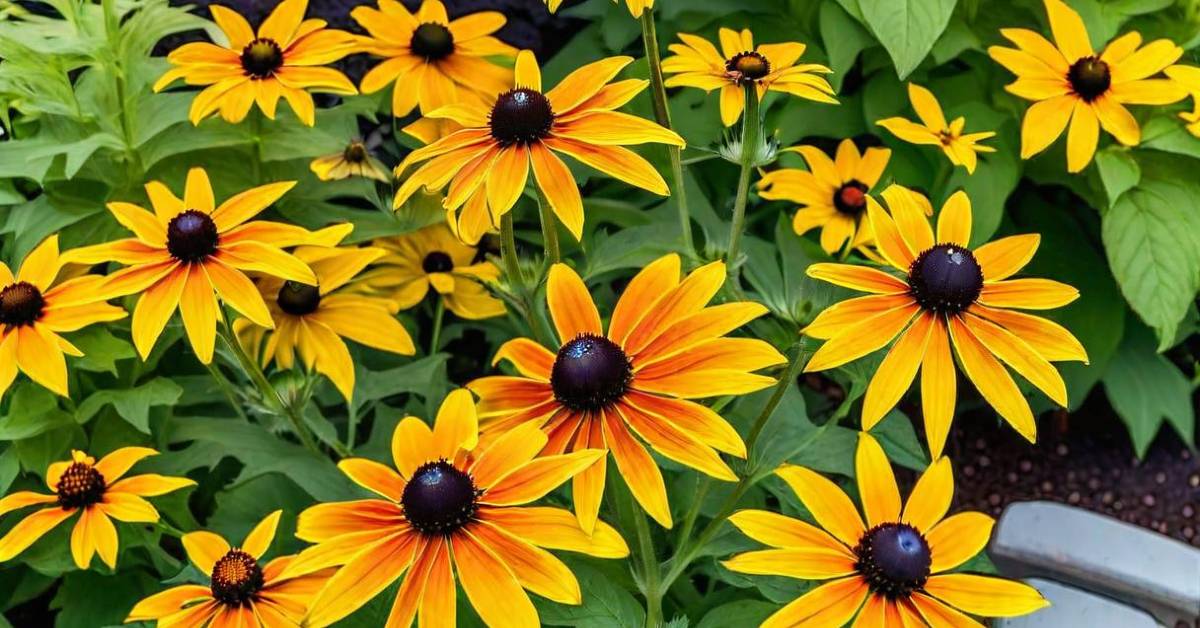
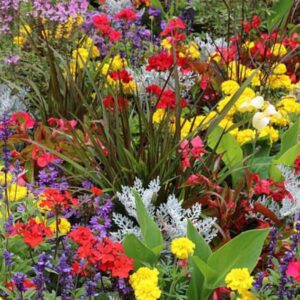
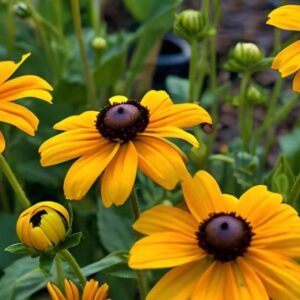
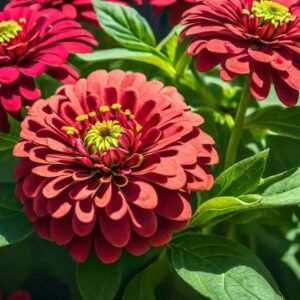
Pingback: Apple Cactus Plant | A Complete Guide in 2024